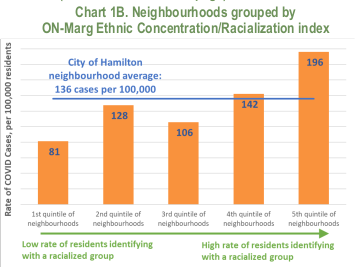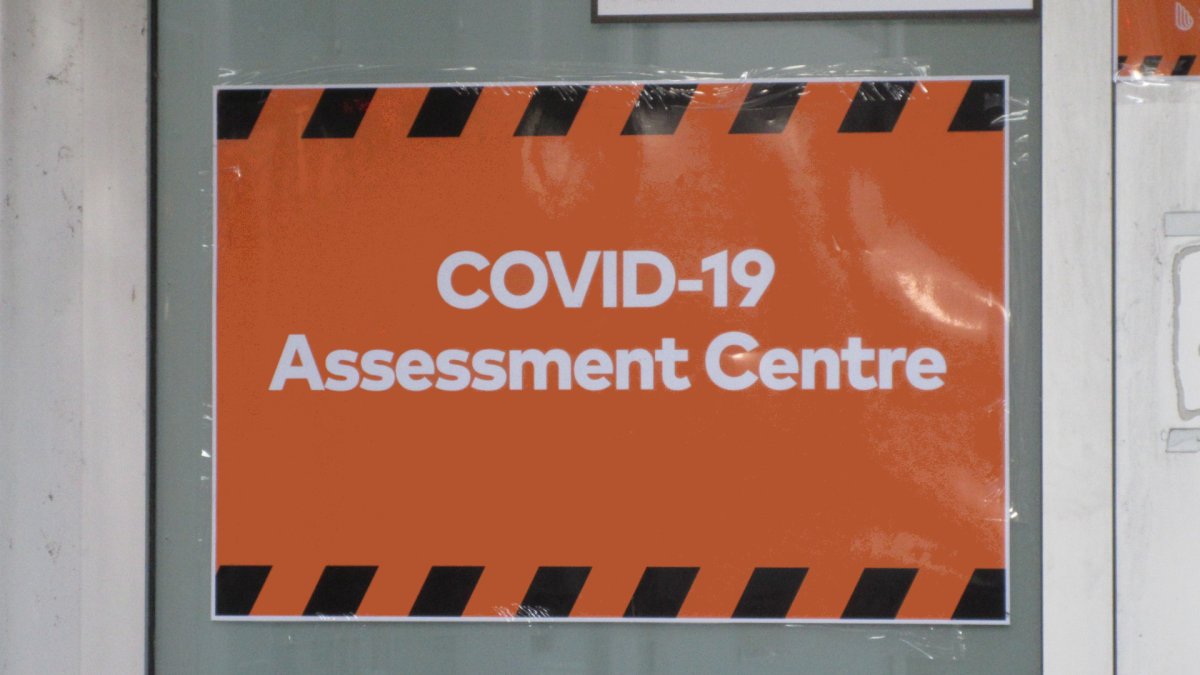A social planner says she was a bit surprised by a study showing that Hamilton, Ont. neighbourhoods with high concentrations of people living on low incomes and those who identify with a racialized group have significantly higher rates of COVID-19.

“We were sort of expecting it, but at the same time, I was surprised by the level of difference between groups in neighbourhoods in this analysis,” Sara Mayo said about research from the Social Planning and Research Council (SPRC).
“Racialized neighbourhoods with higher proportions of racialized residents, the rate was even more than double,” Mayo told Global News.
On Monday, the SPRC revealed an examination that combined Hamilton’s pandemic data with neighbourhood census data from the Ontario Marginalization Index.
That report says neighbourhoods with high rates of residents identifying with a racialized group had an average of 196 cases per 100,000 people in the city during the pandemic, more than double the 81 cases per 100,000 in neighbourhoods claiming to have a lower rate of those identifying with a racialized group.

The study also shows that neighbourhoods with a ‘high rate of material deprivation,’ or low incomes, had an average of 179 cases per 100,000 people between the start of the pandemic and Aug. 5, 2020.
That’s 43 more cases than the city’s average number of cases (136 per 100,000) over the same time period.
Meanwhile, the city’s richest neighbourhoods only had 99 cases per 100,000 residents.

The data also finds that neighbourhoods in between the richest and the poorest saw COVID-19 cases climb with increased material deprivation, or declining incomes.

Get daily National news
Mayo says the trends were analyzed at the neighbourhood level and were not about specific geographic areas of the city.
The report suggests the disparities are not unique to Hamilton drawing that conclusion from similar data collected by Toronto’s public health unit last month which also showed racialized and lower-income neighbourhoods were disproportionately affected by the ongoing pandemic.
Numbers from Toronto paint a “clearer picture” of what specific groups are affected, according to the SPRC, with Latin American, Middle Eastern and West Asian residents having the highest rates of infection, and white and East Asian groups showing the lowest risk.
Mayo suggests that the numbers may be connected to precarious employment and cramped housing conditions among poor and racialized residents.
“It is so much harder for people to socially isolate if they’re living in overcrowded housing, ” said Mayo.
Hamilton’s recent COVID-19 cases trend younger
Hamilton public health says more than half of the city’s new coronavirus cases in the last 10 days have come from people under the age of 30.
The agency reported that 51 per cent of its 45 recent cases came from residents aged 29 and under, with those between 20 and 29 accounting for 20 per cent of all cases.
Sixty-four per cent of the city’s cases in the last 10 days are connected to people with a close or casual contact who had no travel history.
Since the pandemic, Hamilton has a total of 973 confirmed cases which includes 45 deaths.
The city has no current institutional outbreaks.
Niagara Region with 1 new COVID-19 case
Niagara public health reported only one new COVID-19 case on Monday, with 28 active cases.
The region now has 930 total cases and 64 people have died in connection with the COVID-19 pandemic.
Halton Region with 4 new COVID-19 cases
Public Health Halton reported four new COVID-19 cases on Aug. 24. The region has 956 total cases, with 26 active cases.
The region still has 25 deaths tied to COVID-19 as of Monday.
The region has no current institutional outbreaks.
Haldimand-Norfolk with no new COVID-19 cases
Haldimand-Norfolk Health Unit (HNHU) reported no new COVID-19 cases on Monday. The region has an overall total of 474 lab-confirmed, positive cases.
Officials say 419 of those patients have since recovered.
The region has 32 COVID-19-connected deaths with 27 among residents at Anson Place Care Centre, a nursing home in Hagersville.
There is one institutional outbreak at Parkview Meadows Christian Retirement Village in Townsend after one staff member tested positive on Aug. 18 .
The region currently has 23 active cases.
Brant County reports no new COVID-19 cases
After reporting six new COVID-19 cases on the weekend, Brant county’s Health unit revealed no additional cases on Monday.
The region has 160 confirmed cases as of Aug. 24, and five deaths since the pandemic began.
There are no reported outbreaks and the county has 12 active COVID-19 cases.














Comments